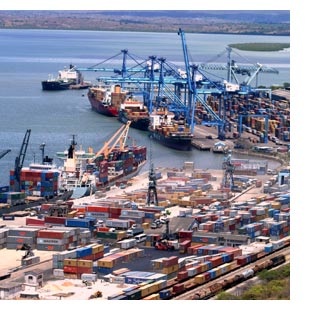
| Southern ports dragging the chain | |
A number of seaports in Ho Chi Minh City’s outskirts are underperforming, causing a huge waste of infrastructure and undermining the city’s competitive advantage. In light of the state’s commitment to removing seaports from the inner city to the outskirts, new seaports were built in the suburbs but actual goods handling volumes at these ports remained low chiefly due a lack of access roads, according to director of Ho Chi Minh City Transport Department Tran Quang Phuong. “The city’s ports are losing customers since many companies now bring their goods to some other ports in Ba Ria Vung Tau province. If things continue, we will possibly lose 50-70 per cent of the goods handling volume in the next five years,” Phuong said. He pointed out to District 9’s Phu Huu port case. Accordingly, the port was built from 2007 and completed construction in July, 2010 to supersede Ben Nghe port on Saigon River when the latter was due to be removed. However, big trucks could not access the port because the 2.5 kilometre long Go Cat access road was of poor quality. Consequently, since being active the port received only five small ships despite its fairly modern port facilities. Phu Huu port’s developer Ben Nghe Port Company Limited director Nguyen Ngoc Thao said the building of an access road from Nguyen Duy Trinh road to Phu Huu Industrial Zone (IZ) was approved by the city’s people’s committee in late March, 2011. Accordingly, the project will be developed by Ha Tien 1 Cement Joint Stock Company with a total investment of VND461 billion ($22.3 million). The Saigon-Hiep Phuoc port complex on the Soai Rap River, developed by Saigon Port Corporation, incurred the same fate. As planned, construction of the port’s first phase will be completed in June. However, construction of access road to the port has yet to kick-off. To shed some light on the retardation, deputy director of the Ho Chi Minh City Transport Department Bui Xuan Cuong said it was regulated in Ho Chi Minh City-Dong Nai-Ba Ria-Vung Tau seaport group detailed planning towards 2010 with a vision towards 2020 that the capital for building infrastructure facilities outside the ports such as roads, electricity, water and communication systems would be sourced from the state budget. In fact, D3 road leading to the port is one of Hiep Phuoc IZ’s internal roads, so that it must be upgraded by IZ developer Tan Thuan Industrial Promotion Company Limited IPC. However, IPC argued that since the road is mainly used to transport goods to the port, businesses must share part of the access road’s construction cost. The city’s people’s committee reportedly asked the prime minister for a VND500 billion ($24.1 million) loan package from the state budget to build the access road to the port. The city’s seaports were losing their comparative advantages, said Ho Chi Minh City Goods Transport Association general secretary Thai Van Chung. “The city’s ports face tough competition from regional ports in Can Tho, Thi Vai-Cai Mep port in Ba Ria Vung Tau and prospective Long An international port in Can Giuoc district whose construction was just kicked-off though up to 70 per cent of import goods in southern areas are calling on the city’s ports,” Chung said. | |
| Vietnam Investment Review |
